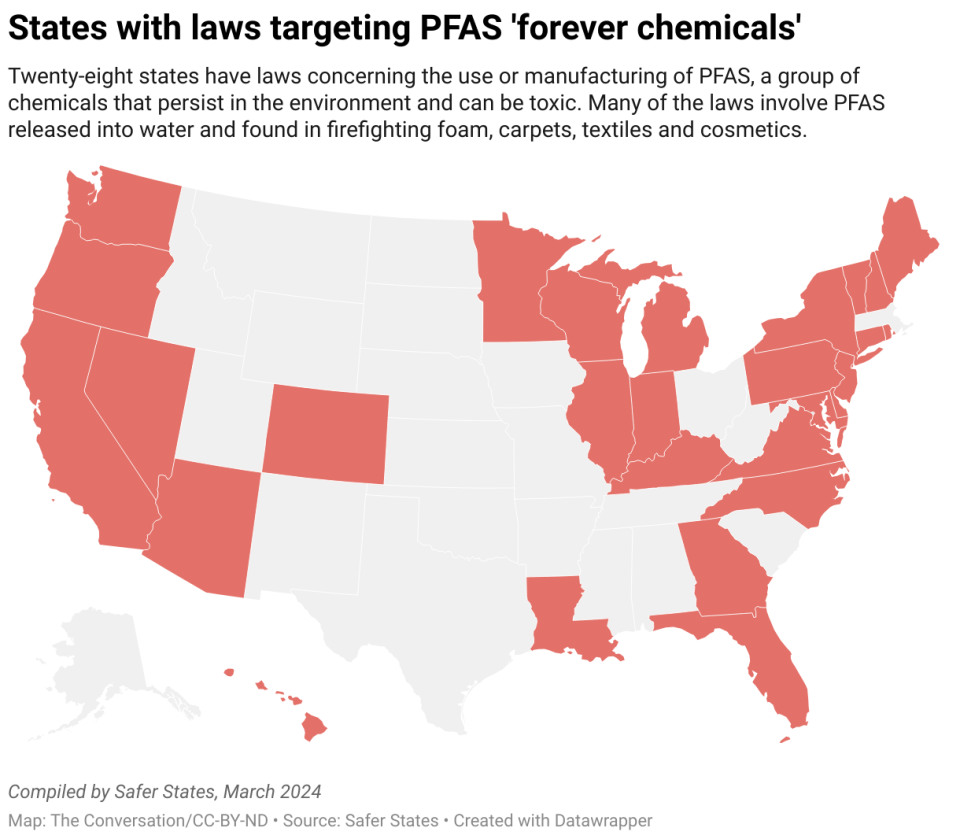These “forever chemicals” are becoming more concerning as scientists learn about the health risks of PFAS, found in everything from nonstick cookware to carpets to ski wax.
The U.S. Environmental Protection Agency no longer believes that there is a safe level for two common PFAS (PFOA and PFOS) in drinking water and recognizes that very low concentrations of other PFAS pose risks to human health. On April 10, 2024, the agency published the first legally enforceable national drinking water standards for five common types of PFAS chemicals and PFAS mixtures.
I study PFAS as an environmental health scientist. Here’s a quick look at the risks posed by these chemicals and efforts to regulate them.
What exactly are PFAS?
PFAS refers to per- and polyfluoroalkyl substances. This is a large group of man-made chemicals, currently estimated to number approximately 15,000 individual chemical compounds, that are widely used in consumer products and industry. They can make products resistant to water, oil and stains and protect against fire.
Waterproof outdoor clothing and cosmetics, stain-resistant flooring and carpeting, food packaging designed to prevent liquid or oil from leaking, and some firefighting equipment often contain PFAS.
In fact, studies have found that most products labeled as stain- or water-resistant contain PFAS, and another study found this to be true even for products labeled “non-toxic” or “green.” PFAS are also found in unexpected places, such as high-performance ski and snowboard waxes, floor waxes, and medical devices.

At first glance, PFAS sounds pretty useful, so you might be wondering what the big deal is?
The short answer is that PFAS are harmful to human health and the environment.
Some of the same chemical properties that make PFAS attractive in products also mean that these chemicals will remain in the environment for generations. Due to the widespread use of PFAS, these chemicals are now present in water, soil, and living organisms and can be found almost everywhere on the planet, including Arctic ice caps, marine mammals, remote communities living on subsistence diets, and 98% of the world’s population. American public.
The U.S. Geological Survey estimates that common types of PFAS are currently found in at least 45% of the nation’s tap water. PFAS manufacturer 3M, which is facing lawsuits, announced a deal worth at least $10.3 billion in June 2023 under which public water systems will cover the costs of PFAS testing and treatment.
What are the health risks of exposure to PFAS?
When people are exposed to PFAS, the chemicals remain in their bodies for a long time (months or years, depending on the particular compound) and can accumulate over time.
Research consistently shows that PFAS are associated with a variety of adverse health effects. The review by a panel of experts who reviewed the research on PFAS toxicity concluded with a high degree of certainty that PFAS contribute to thyroid disease, high cholesterol, liver damage, and kidney and testicular cancer.


They also concluded that PFAS also affects babies exposed in the womb by increasing the likelihood of being born with lower birth weight and responding less effectively to vaccines, while it may also negatively impact the mother’s health by negatively affecting women’s mammary gland development. ability to breastfeed.
The review also found evidence that PFAS may contribute to a range of other disorders; but more research is needed to confirm current findings: inflammatory bowel disease, decreased fertility, breast cancer, and an increased likelihood of miscarriage and the development of high blood pressure and preeclampsia during pregnancy. pregnancy. Additionally, existing research shows that prenatally exposed infants are at higher risk of experiencing obesity, early onset of puberty, and decreased fertility later in life.
Collectively, this is a formidable list of diseases and disorders.
Who regulates PFAS?
PFAS chemicals have been around since the late 1930s, when a DuPont scientist accidentally created one during a laboratory experiment. DuPont called it Teflon, and it eventually became a household name for its use in nonstick pans.
Decades later, in 1998, Scotchgard manufacturer 3M notified the Environmental Protection Agency that a PFAS chemical had been detected in human blood samples. At the time, 3M said low levels of the chemical produced in people’s blood had been detected in the early 1970s.
The Agency for Toxic Substances and Disease Registry has a toxicological profile for PFAS. EPA has also issued recommendations and health-based guidelines. But despite the long list of serious health risks associated with PFAS and the enormous amount of federal investment in PFAS-related research in recent years, PFAS has remained unregulated at the federal level in the United States until now.
The new drinking water standards set limits for five individual PFAS (PFOA, PFOS, PFNA, PFHxS and HFPO-DA) and mixtures of these chemicals. The standards are part of the EPA’s roadmap for PFAS regulations.
EPA also proposed listing nine PFAS as hazardous substances under the Resource Conservation and Recovery Act; It’s a move that concerns utilities and businesses that use products or processes containing PFAS due to the cost of cleanup.


While we await federal action, states have taken their own steps to protect their residents from the risk of PFAS exposure.
At least 28 states have laws targeting PFAS in various uses such as food packaging and carpeting. About a dozen have drinking water standards for PFAS. But relying on state laws creates a set of regulations that burden businesses and consumers with managing regulatory nuances across state lines.
How can you reduce your exposure to PFAS?
Based on current scientific understanding, most people are exposed to PFAS primarily through diet, but exposure through drinking water and air may be significant among some people, especially if they live near known PFAS-related industries or contamination.
The best way to protect yourself and your family from PFAS-related risks is to educate yourself about potential sources of exposure.
Products labeled as water or stain resistant have a high chance of containing PFAS. Whenever possible, check the ingredients of the products you buy and look out for chemical names that contain “fluorine-“. Certain trade names, such as Teflon and Gore-Tex, are also likely to contain PFAS.
Check to see if there are sources of contamination near you, such as drinking water or PFAS-related industries in the area. Strategies for monitoring and reporting PFAS contamination vary by location and PFAS source; Therefore, the lack of readily available information does not necessarily mean that the area is free of PFAS problems.
For additional information about PFAS, see the Agency for Toxic Substances and Disease Registry, EPA, and U.S. Centers for Disease Control and Prevention websites, or contact your state or local public health department.
If you think you have been exposed to PFAS and are concerned about your health, contact your healthcare provider. The National Academies of Sciences, Engineering, and Medicine has published guidance on PFAS exposure, testing, and clinical monitoring, which includes information to help healthcare professionals understand the monitoring and clinical consequences of PFAS exposure.
This is an update to an article first published on June 21, 2022.
This article is republished from The Conversation, an independent, nonprofit news organization providing facts and authoritative analysis to help you understand our complex world. Written by Kathryn Crawford middlebury
Read more:
Kathryn Crawford receives funding from the National Institutes of Health and the US Geological Survey.